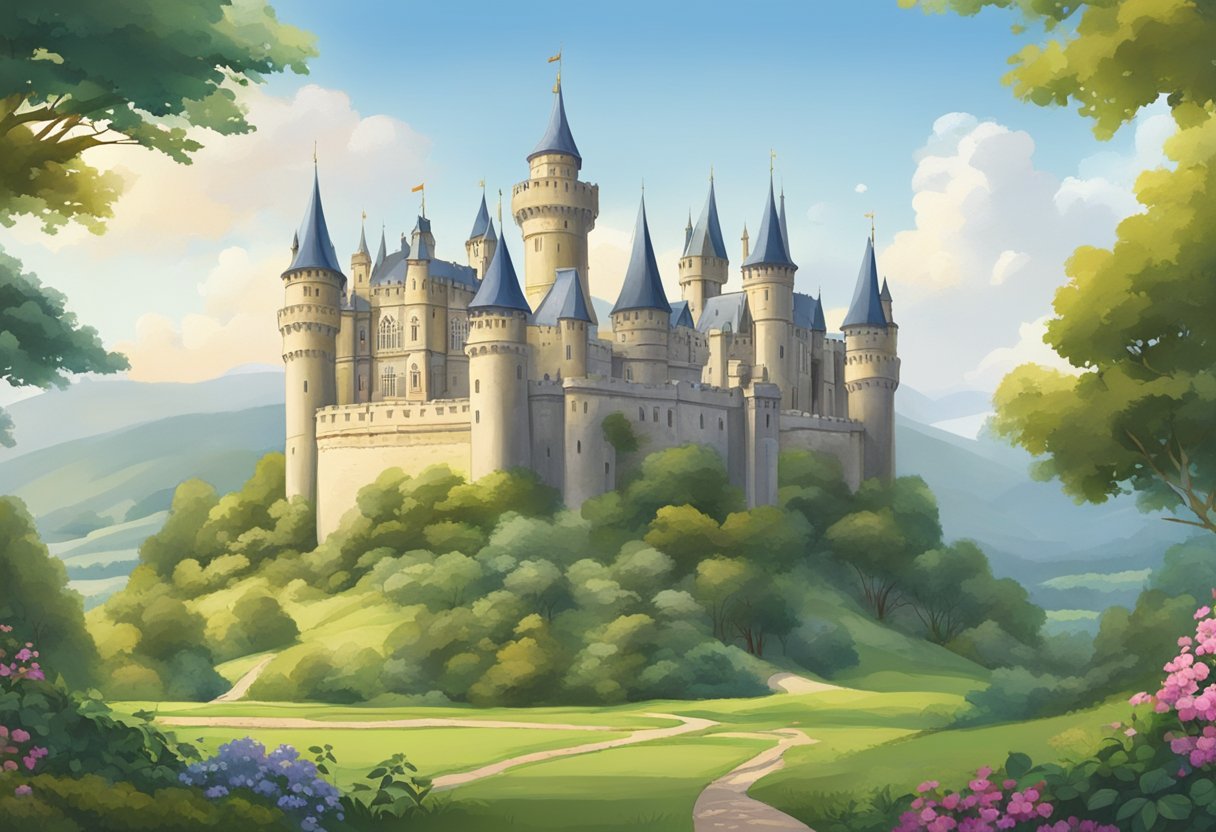England’s landscape is generously dotted with a wealth of castles and palaces, each whispering tales of the past with an air of nobility and a slight English accent, of course. They stand as stone-clad testaments to the country’s tumultuous history, with ramparts that have withstood sieges and ballrooms that have echoed the laughter of courtiers.
For the modern visitor, these edifices offer a chance to walk through living history, to touch the ancient stones and momentarily be a part of England’s storied heritage.

Each castle and palace in England has a unique story to tell, with variations in design that span centuries and styles. Whether you fancy the stoic might of a Norman keep or the refined elegance of a Tudor court, England’s finest offer an architectural feast for the eyes.
Tours and exhibitions breathe life into these historical homes, inviting you to explore lavish state rooms, stand on battle-worn battlements, and stroll through manicured gardens.
Key Takeaways
- England’s castles and palaces are historical beacons that illuminate the country’s past.
- Architectural diversity abounds, from Norman fortifications to Tudor palaces.
- Interactive tours offer an immersive glimpse into England’s noble way of life.
A Journey Through Time: The History of English Castles
The tapestry of English history is richly embroidered with the imposing presence of castles. From wooden motte and bailey structures to grand stone fortresses, they’ve been silent spectators to a past punctuated by conquests, regal dramas, and the odd ghost or two.
Norman Conquest and the Early Castles
- 1066: William the Conqueror invades England, bringing with him the Normans’ penchant for building formidable castles.
- Motte and Bailey castles: Quick to construct wooden defenses, a symbol of the Normans’ throttling hold on England.
Post the tumult of the Norman invasion, these early castles sprouted like mushrooms after a rainstorm, signifying the beginning of a new era. The Normans weren’t just superbly good at winning battles; they were the IKEA of their day—masters of flat-pack castle assembly with the motte and bailey designs.
Medieval Fortifications and Royal Dwellings
- Design: Stone upgrades replaced wood, transforming castles into both military fortresses and opulent palaces.
- Middle Ages: Castles turned into symbols of power, where royalty including Henry VIII and Elizabeth I played house.
During the Middle Ages, fortifications saw a glow-up, graduating from rudimentary timber to stellar stone. They weren’t just for keeping the baddies at bay; they became the medieval equivalent of a penthouse suite, replete with moats, drawbridges, and the occasional execution for good measure.
Storming the Castles: Sieges and Civil Wars
- Siege: Castles, like sandcastles against the tide, often fell to innovative siege tactics.
- Civil War: The 17th century saw castles recurrently caught in the crossfire—some got a bit crumbly in the process.
Castles had their work cut out for them during the sieges and civil wars. It turns out size does matter, as those with thicker walls often gave as good as they got. But in some cases, like during the English Civil War, what cannonballs started, Cromwell finished.
The Romantic Revival of Castles
- 19th Century: The Victorians went full HGTV, bringing back castles as must-haves.
- Romanticism: Castles became less ‘winch the portcullis’ and more ‘throw the white party’.
Surprise, surprise, castles made a comeback during the 19th century. No longer just relics of the past, they were now the settings for lavish balls and afternoon teas on the lawn—because nothing says ‘romance’ like a draughty great hall.
The revival had the Victorians swooning and refurbishing, giving these stoney piles the love they deserved after centuries of neglect.
England’s Finest: Highlighting Notable Castles and Palaces
England’s landscape is dotted with historical gems that have stood the test of time. From regal estates that have housed monarchs to formidable fortresses that have seen battles and sieges, each of these structures tells its own unique story.
Regal and Resilient: Tower of London and Windsor Castle
- Tower of London: A historic fortress where jewels dazzle and ravens rule.
- Founded by William the Conqueror in 1066
- Home to the Crown Jewels
- Windsor Castle: The royal residence that’s often the Queen’s weekend retreat.
- Built by William the Conqueror
- Henry III added the luxurious touch to the castle interiors
Tales of intrigue whisper through the chambers of the Tower of London. It isn’t just the Crown Jewels gleaming—they say the regal ravens are the real monarchs here.
Meanwhile, Windsor Castle stands as a testament to longevity, continuously inhabited since the days of Henry III—who clearly had a thing for splendid abodes and fancied a tudor-style remodeling.
Chivalry in Stone: Warwick and Dover Castles
- Warwick Castle: Where armour rustles and tales of chivalry echo.
- Built by William the Conqueror in 1068
- Known for its dramatic history and knights’ tales
- Dover Castle: A coastal guardian boasting an impressive medieval lighthouse.
- Often called the “Key to England” due to its defensive significance
- Features a Roman lighthouse and wartime tunnels
Warwick Castle might seem quiet now, but imagine knights clanking around, probably lost all the time—castle corridors are confusing. Then there’s Dover Castle: strategically overlooking the Channel, it was essentially England’s medieval alarm system.
Its lighthouse warning: “Oi, invaders, think twice!”
Royal Abodes and Lush Gardens: Hampton Court and Leeds Castle
- Hampton Court Palace: A Tudor triumph with gardens you could get lost in… and many do.
- Famous for its maze
- Once the home of Henry VIII
- Leeds Castle: The loveliest castle in the world? It’s got a moat, so it’s in the running.
- Surrounded by 500 acres of parkland
- Notable for its aviary and labyrinth of gardens
They say Henry VIII loved a good banquet and apparently a sprawling kitchen to match, evidenced by the grandeur of Hampton Court Palace. Its gardens are no afterthought; they’re a green-fingered utopia complete with a medieval GPS challenge—the maze.
Meanwhile, Leeds Castle flirts with perfection, surrounded by water like it’s starring in its own fairytale. Yes, it has a moat—no alligators included, though surely that would have been a stellar medieval security system.
Exploring the Architectural Majesty
England’s castles and palaces offer a smorgasbord of architectural splendor. They stand as towering testaments to history and craftsmanship, with each stone telling its own story of battles, banquets, and bygone eras.
Turrets, Moats, and Gates: The Defining Features
These medieval fortresses didn’t skimp on curb appeal. Castles were the ultimate status symbols with their:
- Turrets: Perfect for spotting friends, foes, or the occasional lost tourist from a mile away.
- Moats: Not just a decorative water feature but a nifty deterrent for unwanted guests (think pesky door-to-door salesmen from the Middle Ages).
- Gates: Imposing entrances that whispered “trespassers will be catapulted” long before trespassing laws were a thing.
One must appreciate a structure that combines defence and dramatic flair in such a grandiose fashion.
From Ruins to Restoration: Preserving the Past
The commitment to preservation of these stone-clad celebrities of the historical world is no laughing matter. Behold the efforts:
| Status | Castles |
|---|---|
| Ruins | They’ve seen better days, but their crumbling walls could tell tales. |
| Restored | Thanks to the itch to stitch history back together, they’re looking pretty spiffy. |
English Heritage wears a cape when it comes to conservation, ensuring future generations can step back in time without a Delorean. Whether it’s keeping fortifications fortified or ensuring every turret is up to snuff, they put the “work” in “masonry work.”
Experiencing Castle Life: Tours and Exhibitions
One might think that getting a taste of noble life is a thing of the past, but fear not! England’s castles and palaces are more than crumbling walls and ghost stories. They invite you to strut through their grand halls and explore their exquisite gardens as if you were lord or lady of the manor.
- Hever Castle: They say a visit to Hever Castle is like stumbling into a medieval romcom. With its sumptuous interiors and a water maze that’s sure to leave any visitor giggling wetly, it’s no wonder visitors feel like they’ve stepped onto the set of a Shakespearean play. Expect droughts of history instead of draughts of ale!
- Leeds Castle: Fancy a cheeky jaunt through a 900-year legacy? Leeds Castle, allegedly the world’s loveliest castle, is where you’d perfect your royal wave. Armed with a guided tour, visitors can glide through the opulent rooms, dodge peacocks in the formal gardens, or try not to fall into the moat. Talk about a refreshing experience.
- Windsor Castle: Those with a penchant for period dramas can feast their eyes on the same scenes enjoyed by the Queen herself. At this World Heritage Site, the term ‘sprawling estate’ takes on new meaning—especially when one is wandering the vast gardens, pretending to be in an episode of “Downton Abbey.” Visitors can marvel at period furniture that’s sturdy enough to withstand centuries of royal posteriors.
With gardens to frolic in and tunnels to explore, England’s historical homes aren’t just a feast for the eyes, but playgrounds for the imagination. Sure, one might not find a Wi-Fi password etched in the dungeon walls, but they’ll find something much better—stories etched in stone.


Leave a Reply